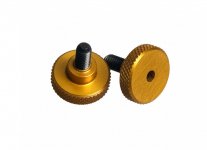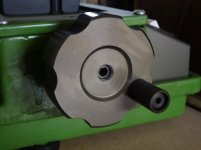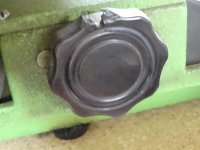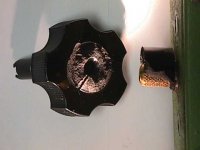Hi guys,
I have a problem. Actually, I have a knob. Which has become a problem.
It's a little tension clamping knob, 8-32 set screw backed into a custom 6061 ************************.
Class 2 ano, Class 3B threads, that check as in band with a plug guage. (rollformed, balex taps.)
Locked up with loctite 263 at assembly.
Or at least they should be. Lately we've been having issues with them breaking loose as users go to unclamp the knobs from their tight position. Failure is that the knob unscrews off the back of the setscrew rather than the whole thing unscrewing out of the clamp body.
History: we've made them for years, and for years, they've worked fine.
Then we had a batch of screws come in oiled with something that the normal red loctite *really* didn't like.
So we started washing the screws off in the parts washer, and switched to loctite 263 red, because if its oil tolerance.
So that way even if they weren't *perfectly* degreased, they were good enough.
Or maybe not. They do check as OK. We've run them up against a torque screwdriver to get some sense for how many inch pounds it takes to get the glue to fail, and it's regularly up north of 40+ in/lb. For a hand tightened knob, that's plenty. It's equivalent to existing old stock parts.
We figured out about the loctite not playing nice with the oil about 3-4 months ago, and started washing the screws at that point. So I *think* we've got the problem licked.
Except we keep getting reports of failures in the field. I think most of those are old stock that got shipped before we figured out about the oiled screws. But I'm not sure that *all* of them are. (There were probably 6 months of production shipped with the oiled screws before we figured out what was going on, so there are a lot of them out there to be causing problems.)
So, I'm looking for ideas of how to be damned sure the problem's dead. I have a swiss, and can machine the knobs any way I like, but we do these things by the thousands, so I'd prefer not to do anything that requires massive extra time, or hand assembly. We have enough of that as it is. Frankly, I'd like it if the loctite just worked dependably. (I'm going to call their engineering people Monday AM.)
I'll attach a picture of the knobs to the end of this.
My only ideas for making *sure* it's dead are to rig a jig on the grinder, and grind a flatspot on the tail end of the screw.
Assemble with loctite as normal, then stick them into a press that has a female cone die in it, and coin the upper end of the spud on the rear of the knob to force it to deform into the flatspot. Which is one manual load/strike/unload cycle per part, nevermind loading the grinding jig, and doing the grinding. Not something I want to do if I have a choice. The setscrews are grade 8, so drilling them isn't much of an idea either.
My other idea is to smack the mouth of the threaded hole in the nut with a dull (rounded) cold chisel, to upset the mouth of the thread. So it's tight as you back the screw in. Except that (A) it'll make it hard to start the thread, and (B) the whole depth of the seated screw will have to roll past that point, so it'll deform back to a tight thread fit, rather than seizing up solid.
Anybody got any suggestions?
Thanks,
Brian

I have a problem. Actually, I have a knob. Which has become a problem.
It's a little tension clamping knob, 8-32 set screw backed into a custom 6061 ************************.
Class 2 ano, Class 3B threads, that check as in band with a plug guage. (rollformed, balex taps.)
Locked up with loctite 263 at assembly.
Or at least they should be. Lately we've been having issues with them breaking loose as users go to unclamp the knobs from their tight position. Failure is that the knob unscrews off the back of the setscrew rather than the whole thing unscrewing out of the clamp body.
History: we've made them for years, and for years, they've worked fine.
Then we had a batch of screws come in oiled with something that the normal red loctite *really* didn't like.
So we started washing the screws off in the parts washer, and switched to loctite 263 red, because if its oil tolerance.
So that way even if they weren't *perfectly* degreased, they were good enough.
Or maybe not. They do check as OK. We've run them up against a torque screwdriver to get some sense for how many inch pounds it takes to get the glue to fail, and it's regularly up north of 40+ in/lb. For a hand tightened knob, that's plenty. It's equivalent to existing old stock parts.
We figured out about the loctite not playing nice with the oil about 3-4 months ago, and started washing the screws at that point. So I *think* we've got the problem licked.
Except we keep getting reports of failures in the field. I think most of those are old stock that got shipped before we figured out about the oiled screws. But I'm not sure that *all* of them are. (There were probably 6 months of production shipped with the oiled screws before we figured out what was going on, so there are a lot of them out there to be causing problems.)
So, I'm looking for ideas of how to be damned sure the problem's dead. I have a swiss, and can machine the knobs any way I like, but we do these things by the thousands, so I'd prefer not to do anything that requires massive extra time, or hand assembly. We have enough of that as it is. Frankly, I'd like it if the loctite just worked dependably. (I'm going to call their engineering people Monday AM.)
I'll attach a picture of the knobs to the end of this.
My only ideas for making *sure* it's dead are to rig a jig on the grinder, and grind a flatspot on the tail end of the screw.
Assemble with loctite as normal, then stick them into a press that has a female cone die in it, and coin the upper end of the spud on the rear of the knob to force it to deform into the flatspot. Which is one manual load/strike/unload cycle per part, nevermind loading the grinding jig, and doing the grinding. Not something I want to do if I have a choice. The setscrews are grade 8, so drilling them isn't much of an idea either.
My other idea is to smack the mouth of the threaded hole in the nut with a dull (rounded) cold chisel, to upset the mouth of the thread. So it's tight as you back the screw in. Except that (A) it'll make it hard to start the thread, and (B) the whole depth of the seated screw will have to roll past that point, so it'll deform back to a tight thread fit, rather than seizing up solid.
Anybody got any suggestions?
Thanks,
Brian






